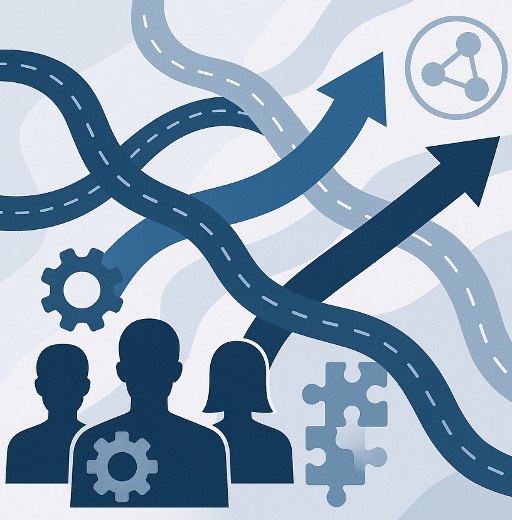Change Management in Route Optimization Projects
Algorithms, software, and maps are usually the first things that come to mind in route optimization. But alongside these, there is a much more important topic: the “human side.” Even if you use a powerful optimization system, if drivers, field sales teams, and managers do not internalize the new system, the project risks not achieving the expected impact.
With the technical infrastructure of route optimization in place, change management plays a critical role. Here, we will look at how resistance forms among field teams and how this resistance can be managed.
Why do some route optimization projects fail to reach the targeted level?
In route optimization projects, we often hear statements like: “If we choose the right software, we can solve everything.”
While the right software matters, organizational problems may appear during the implementation stage after the system decision.
-
The project may be treated solely as a software project.
-
Field teams are not included in the process design. The new system is communicated as a decision they must “simply apply.”
-
Existing habits—such as drivers planning their own routes or sales reps shaping their plans based on personal relationships with customers—are not taken into account.
-
Since KPIs are not set correctly and clearly, the question of whether the project succeeded remains unanswered.
The result:
The driver says he still prefers his old route and refuses to give it up. He does not apply the algorithm’s correct decision. The sales representative continues to follow their own visit frequency, claiming their customer relationships are different. The project remains on paper and is not implemented in practice.
Main reasons for resistance among field teams
Understanding the root causes of resistance is the starting point of change management. Resistance is often fueled by uncertainty and fear.
1. Drivers
-
“The software won’t know the roads I know by heart.”
-
“Will I be punished because of this system?”
-
“Will there be more pressure, will my performance constantly be measured?”
For drivers, route optimization can trigger feelings that their authority is decreasing or disappearing.
2. Field sales teams
-
“Everything feels imposed now, I used to create my own plan.”
-
“Will this system make me lose customers?”
-
“It feels like the software is interfering with my customer relationships.”
The most important and sensitive topic for sales reps is relationship management. If this dynamic is overlooked during planning, resistance grows even stronger.
3. Middle managers
-
More visible and clear KPI results may create “accountability” concerns.
-
Worries about control shifting from them to the software.
-
Additional workload and extra meetings during the adaptation period after the new system is introduced.
Each role has different concerns and motivations. Therefore, the messages given to each group must also be different.
5 Important Steps in Managing Change
1. Management Sponsorship and Clear Goals
The first question when starting a route optimization project should be:
“What is the purpose of this project? What will we have changed and achieved after one year?”
Goals: reducing total km, reducing number of vehicles, increasing customer satisfaction, reducing delivery time.
Top management ownership: The project should be positioned not only as a technology initiative but also as a strategic corporate objective.
This goal should be expressed to the field in a simple and clear way:
More accurate planning, less stress, less confusion.
2. A Controlled Start with a Pilot Region
The approach of “we are changing the system nationwide in one day” is risky and may lead to chaos. Therefore, a few cities or one region should be selected as a pilot.
-
Testing in regions with different density and profiles
-
Collecting feedback on both operations and field team experiences
-
After the pilot period, comparing pre-pilot and post-pilot results with data and user experience
3. Co-Creating the Rule Set with Field Teams
Instead of directly dictating the route and path to follow, it is healthier to follow an approach where field teams are part of the process.
Discussing real obstacles and challenges with drivers:
-
Time windows
-
Vehicle constraints
-
Customer preferences
Setting relationship management rules with sales teams:
-
Special situations
-
Special customers
-
Visit frequency
This approach breaks the perception of a top-down project imposed on them. It creates a sense of ownership: “This is a new way of working we designed together.”
4. Shadow Usage Period and Feedback System
Change does not happen instantly; especially for field teams, learning by experiencing is crucial.
-
Training sessions: Not only technical usage, but also answering the question “What will change in my daily work?”
-
Shadow period: Old and new systems run together for a certain period, allowing comparisons.
-
Feedback channel: A simple channel for the field team to share real-time comments, with active monitoring (e.g., WhatsApp/Teams/Telegram groups or weekly short feedback forms).
This allows field teams to feel part of the improvement and to take ownership.
5. Sharing Success Stories and Encouraging with Rewards
Employees are influenced more by examples and colleagues than by rules.
Pilot region improvements:
-
Km, duration, cost, customer complaints, canceled deliveries, etc.
Individual successes:
-
Drivers and sales reps who perform more efficiently with the new system
Small rewards and recognition:
-
Simple thank-yous, sharing success stories in internal communication, small bonuses
To transform the feeling of “this system gives me a headache” into “this system makes my job easier,” visible examples are necessary.
Communication Strategy: Who Should Be Communicated With, and How?
A single message is not enough when managing change. Each level and department has different dynamics and profiles.
For drivers:
Encouraging communication about less complicated routes, predictable working hours, less traffic and fewer wrong addresses, a more planned day, and reduced extra kilometers.
For sales teams:
Highlighting time savings, more planned and correctly timed customer visits, and preventing unnecessary effort through proper planning.
For top management:
Emphasizing clear KPIs, reduced costs, increased efficiency, and the importance of reliable data for future strategic decisions.
KPIs to Track
To make change management measurable in a route optimization project, certain key KPIs should be monitored:
-
Total kilometers traveled
-
Average delivery time
-
Daily visits & deliveries per vehicle
-
Number of customer complaints (late delivery, missed visit, etc.)
-
Field team satisfaction score
Positive changes in these metrics will help convince field teams and top management and support effective change management.
Common Mistakes
-
Treating the field team only as “users” and not including them in the process
-
Switching the entire system overnight
-
Ignoring data quality issues
-
Adopting a rigid, feedback-resistant approach like “This is the new system, get used to it”
-
Focusing only on cost and overlooking the people operating the system
Conclusion
Route optimization projects may appear technically complex. However, the key to success often lies in something very human: changing habits and earning the support of the field.
With the right and effective change management approach:
-
You can reduce resistance from drivers and field teams
-
You can establish a route optimization system that is adopted more quickly
-
You can achieve concrete improvements in cost and customer experience
If you want to design your route optimization project not just as a software change and installation, but as an end-to-end transformation, you can redesign both your technical and organizational roadmap with Geovision’s expert team.




